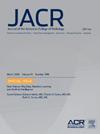Radiology Resident Perspectives on and Experiences With Labor Union Participation
IF 5.1
3区 医学
Q1 RADIOLOGY, NUCLEAR MEDICINE & MEDICAL IMAGING
引用次数: 0
Abstract
Purpose
The aim of this study was to understand the perceptions of radiology residents regarding labor unions and the differences between unionized and nonunionized residents in perceived versus actual benefits of unionization.
Methods
This cross-sectional survey, focused on residents’ experiences with and perceptions of unions, was sent to radiology residency program directors within the 50-member Radiology Residency Education Research Alliance, who subsequently forwarded it to 756 residents across 24 programs. Bivariable analyses were conducted to evaluate differences in opinions between unionized and nonunionized residents regarding benefits and drawbacks of union membership. Additional subgroup analyses were performed for current union members.
Results
A total of 249 responses were received, with 20 excluded because of incomplete data (n = 229, a 30.3% response rate). The majority of residents were very supportive (n = 126 [55.0%]) or somewhat supportive (n = 47, 20.5%) of unions, believing that unions had a positive impact on time off (n = 151 [65.9%]), duty hours (n = 147 [64.2%]), the ability of residents to make their voices heard (n = 156 [68.1%]), resident salaries (n = 183 [79.9%]), resident benefits (n = 190 [83.0%]), and resident wellness (n = 137 [59.8%]). Unionized residents reported more vacation time (20 or more days: 90.4% vs 70.3%; P < .001), more subsidized housing (53.8% vs 5.7%, P < .001), and more technology and education stipends (90.4% vs 81.7%, P = .025) compared with nonunionized counterparts. Nonunionized respondents were significantly more likely to report that unionization positively affected duty hours (70.9% vs 53.9%, P = .026). Additionally, nonunionized residents were more likely to view disciplinary action as a drawback of union membership (14.6% vs 1.9%, P = .011). Although the majority of radiology respondents felt that unionization had neither a positive nor a negative impact on fostering resident-faculty relationships, those from nonunionized programs were significantly more likely than their unionized peers to perceive these relationships as both positively (22.2% vs 9.6%, P = .034) and negatively (33.5% vs 19.2%, P = .044) affected by union membership.
Conclusions
The majority of radiology residents surveyed were supportive of resident unions, believing that unions positively affected time off, duty hours, ability of residents to make their voices heard, salaries, benefits, and wellness.
放射科住院医师对工会参与的看法和经验。
目的:本研究的目的是了解放射科住院医师对工会的看法,以及加入工会与未加入工会的住院医师对工会的感知与实际利益的差异。方法:这项横断面调查主要关注住院医师对工会的经验和看法,该调查被发送给50名成员的放射住院医师教育研究联盟中的放射住院医师项目主任,他们随后将其转发给24个项目的756名住院医师。采用双变量分析来评估加入工会和未加入工会的居民对加入工会的好处和坏处的看法差异。对现有工会成员进行了额外的亚组分析。结果:共收到249份应答,其中20份因数据不完整而被排除(n = 229,应答率为30.3%)。大多数居民非常支持工会(n = 126[55.0%])或比较支持工会(n = 47, 20.5%),认为工会对休假时间(n = 151[65.9%])、工作时间(n = 147[64.2%])、居民表达意见的能力(n = 156[68.1%])、居民工资(n = 183[79.9%])、居民福利(n = 190[83.0%])和居民健康(n = 137[59.8%])有积极影响。工会居民的休假时间(20天以上)分别为90.4%和70.3%;P < 0.001),更多的补贴住房(53.8%比5.7%,P < 0.001),以及更多的技术和教育补贴(90.4%比81.7%,P = 0.025)。未加入工会的受访者更倾向于认为加入工会对工作时间有积极影响(70.9% vs 53.9%, P = 0.026)。此外,未加入工会的居民更有可能将纪律处分视为加入工会的缺点(14.6% vs 1.9%, P = 0.011)。尽管大多数放射学受访者认为,工会组织对培养住院医师与教师的关系既没有积极的影响,也没有消极的影响,但那些来自非工会组织的项目的人比他们加入工会的同行更有可能认为这些关系受到工会成员的积极影响(22.2%对9.6%,P = 0.034)和消极影响(33.5%对19.2%,P = 0.044)。结论:接受调查的大多数放射科住院医师支持住院医师工会,认为工会对休假时间、值班时间、住院医师表达意见的能力、工资、福利和健康有积极影响。
本文章由计算机程序翻译,如有差异,请以英文原文为准。
求助全文
约1分钟内获得全文
求助全文
来源期刊

Journal of the American College of Radiology
RADIOLOGY, NUCLEAR MEDICINE & MEDICAL IMAGING-
CiteScore
6.30
自引率
8.90%
发文量
312
审稿时长
34 days
期刊介绍:
The official journal of the American College of Radiology, JACR informs its readers of timely, pertinent, and important topics affecting the practice of diagnostic radiologists, interventional radiologists, medical physicists, and radiation oncologists. In so doing, JACR improves their practices and helps optimize their role in the health care system. By providing a forum for informative, well-written articles on health policy, clinical practice, practice management, data science, and education, JACR engages readers in a dialogue that ultimately benefits patient care.
 求助内容:
求助内容: 应助结果提醒方式:
应助结果提醒方式:


